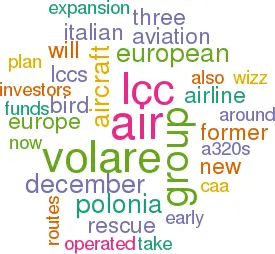European LCCs: Is this the "bloodbath"?
December 2004


The hyperbolic prediction earlier this year by Ryanair CEO Michael O'Leary that there would be a "bloodbath" in the European LCC sector this winter has had the desired effect of unnerving LCC investors.
Partly as a consequence, several of the weaker LCCs have gone bankrupt; others will follow.
The most recent casualty is Warsaw–based LCC Air Polonia, which suspended flights in early December and as Aviation Strategy went to press was urgently searching for a new injection of funds from either LOT or private investors. Air Polonia ran into trouble after it couldn’t afford a $800,000 instalment on the lease of its aircraft, followed by the collapse of a planned €10m loan from an existing Irish investor group. The airline is believed to have debts of around €7m.
Air Polonia was launched as a charter carrier in 2001 but adopted an LCC business model in December 2003. It operated three 737s, three Let L410s and an An–28 on routes from six Polish cities to secondary airports in five European countries, including London Stansted and Paris Beauvais.
Air Polonia’s demise represents a rationalisation of the east/central European LCC market where three players — Air Polonia, Wizz Air and SkyEurope — were at least one too many. Hungarian/Polish airline Wizz now appears to be safe following an injection of €25m from US investor Indigo Partners. Wizz Air operates six A320s on services across Europe, and is now planning a major expansion in 2005, with 10 new routes from Budapest, Katowice and Gdansk.
Air Polonia also wasn’t helped by the problems of alliance partner Volare, the Italian group that includes LCC Volareweb.com and charter carrier Air Europe. The Milan–based Volare Group has 1,400 employees and was founded back in 1994, and its LCC subsidiary operated 17 A320s to France, Spain, the UK, Germany and Belgium.
The group declared itself insolvent at the end of November after it couldn’t pay lease fees, its debt reached the dizzy heights of €300m and attempts to find emergency funding of €60m failed. Volare chairman Mauro Gambaro wants the government to bail out the group but, ironically, Italian law prohibits the state from bailing out troubled companies unless their debt reaches €1bn.
To make matters worse, in November Italian prosecutors began informal questioning of Andrea Molinari, Volare’s former CEO, about potential false accounting and misuse of funds at the group, although no charges have yet been laid. Apparently Deloitte & Touche claim they warned Volare about the precarious nature of its finances as early as 2002. Volare is owned 39% by Argentinean businessman Eduardo Eurnekian and 25% by Ginni Zoccai, former president of Volare. Eurnekian has reportedly agreed an option to buy Zoccai’s stake in March 2007 for €35m, though unless there is a bailout and a remarkable turnaround the option will be worthless.The government has appointed an administrator, Carlo Rinaldi, to try and rescue the group, and he attempted to put together a rescue plan for the Italian civil aviation authority by a deadline of December 10. On that day the CAA stated a rescue plan had been submitted by Volare, but that it lacked sufficient detail on finances.
However, the CAA gave Volare one last chance, by extending the deadline to December 15. If a rescue plan is approved, Volare flights will resume for the Christmas and New Year period, but if it isn’t accepted by the CAA, then other airlines could be authorised to take over Volare’s routes.
In late October, Dutch LCC V Bird went bankrupt owing around €39m to creditors. The airline was launched by Dutch and US investors (including former Air Exel chief Roberto Stinga) in October 2003, but collapsed after the Exel Aviation Group reportedly declined to inject further funds to save the airline.
V Bird employed 190 people and operated a fleet of three A320s — leased from ILFC — to 17 destinations in Europe. V Bird’s main hub was at Niederrhein, a former military airport based just over the border in Germany, and it flew around 700,000 passengers in 2004 before collapsing, claiming a load factor of more than 70%. Talks with potential rescuers for V Bird appear to have petered out, and Germanwings is in negotiations with ILFC to take over V Bird’s leases.
V Bird had hoped to establish itself as a European version of JetBlue, but never achieved much of a profile, blamed on lack of an advertising budget but probably also related to the unattractiveness of its airport base.
A putative long–haul LCC has also failed — Civair which was to have flown 747s between London Stansted and South Africa did not start up in early December as planned, following the withdrawal of backers.
easyJet/Ryanair: expansion and cashflow
Rationalisation through bankruptcy is a rapid process in Europe, the reverse of the explosion of LCCs many of which, though not all, had weak business plans and/or were underfunded.
For easyJet and Ryanair, the development is welcome — they will need the space to expand into as they continue to take two or so new aircraft a month (see Aviation Strategy, June 2004).
Their expansion has now taken on a momentum of its own through their sale and leaseback activity: as aircraft are delivered these LCCs have the opportunity of monetising the deep discounts they received from Airbus and Boeing, by selling the aircraft at market values to leasing companies then leasing them back; in other words, each aircraft delivery potentially boosts the airlines' cashflow.